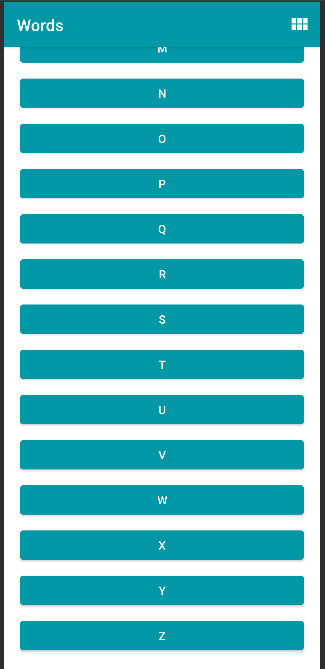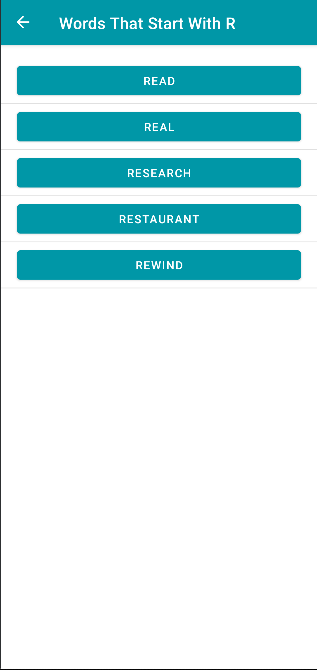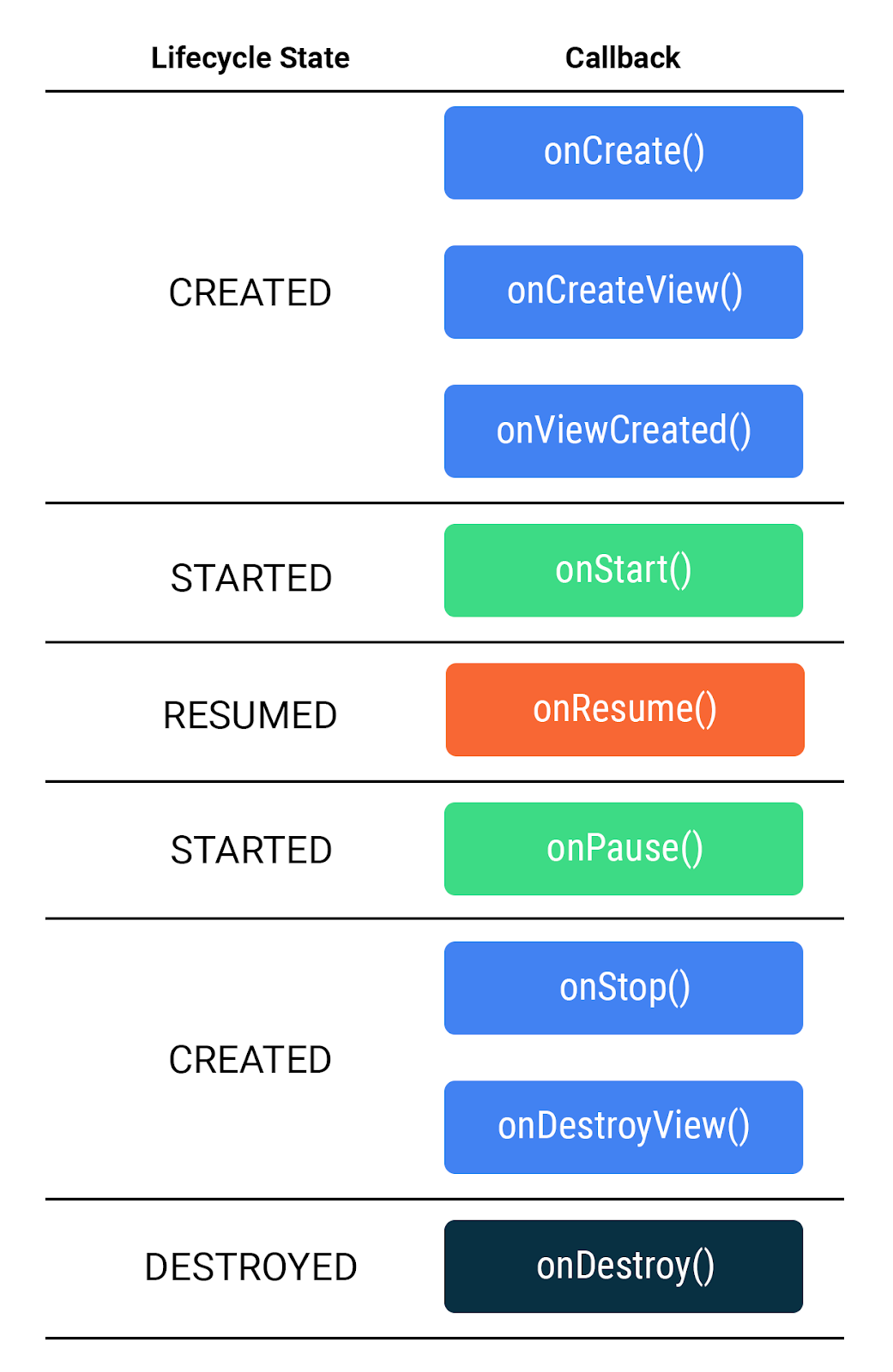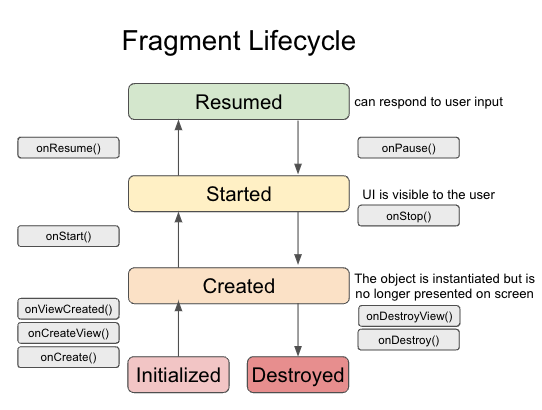Words app allows you to select a letter and use Intents to navigate to an Activity that presents a number of words starting with that letter. Each word can be looked up via a web search.
Words app contains a scrollable list of 26 letters A to Z in a RecyclerView. The orientation of the RecyclerView can be changed between a vertical list or a grid of items.
The app demonstrates the use of Intents in two ways:
- to navigate inside an app by specifying an explicit destination, and,
- allowing Android to service the Intent using the apps and resources present on the device.
Project sourced from:
- Fragments and the Navigation Component
- Starter code for the independent project for google-developer-training/android-basics-kotlin-words-app.
Screenshots of the project
A fragment is a reusable piece of UI; fragments can be reused and embedded in one or more activities.
- switching tabs simply swaps out the previous fragment with another fragment. All of this happens without launching another activity.
- You can even show multiple fragments at once on a single screen
- fragments exist simultaneously in the same activity
- Each fragment manages its own separate lifecycle
- fragments exist simultaneously in the same activity
- A fragment is simply a reusable piece of your app's user interface
- fragments have a lifecycle and can respond to user input
- A fragment is always contained within the view hierarchy of an activity when it is shown onscreen
- fragments' views can be created and destroyed several times throughout the fragment's lifecycle
- Use cases for fragments:
- Using the Navigation component, many apps can manage their entire layout within a single activity, with all navigation occurring between fragments.
- Fragments make common layout patterns possible, such as master-detail layouts on tablets, or multiple tabs within the same activity.
the fragment lifecycle has five states, represented by the Lifecycle.State enum.
- INITIALIZED: A new instance of the fragment has been instantiated.
- CREATED: The first fragment lifecycle methods are called. During this state, the view associated with the fragment is also created.
- STARTED: The fragment is visible onscreen but does not have "focus", meaning it can't respond to user input.
- RESUMED: The fragment is visible and has focus.
- DESTROYED: The fragment object has been de-instantiated.
- onCreate(): The fragment has been instantiated and is in the CREATED state. However, its
corresponding view has not been created yet.
- is called before the view is created, can't inflate the layout here
- onCreateView(): This method is where you inflate the layout. The fragment has entered the CREATED state.
- onViewCreated(): This is called after the view is created. In this method, you would typically bind specific views to properties by calling findViewById().
- onStart(): The fragment has entered the STARTED state.
- onResume(): The fragment has entered the RESUMED state and now has focus (can respond to user input).
- onPause(): The fragment has re-entered the STARTED state. The UI is visible to the user
- onStop(): The fragment has re-entered the CREATED state. The object is instantiated but is no longer presented on screen.
- onDestroyView(): Called right before the fragment enters the DESTROYED state. The view has already been removed from memory, but the fragment object still exists.
- onDestroy(): The fragment enters the DESTROYED state.
- onCreateOptionsMenu(): While the Activity class has a global property called menuInflater, Fragment does not have this property. The menu inflater is instead passed into onCreateOptionsMenu(). Also note that the onCreateOptionsMenu() method used with fragments doesn't require a return statement.
How the fragment lifecycle differs from the activity lifecycle. How to convert an existing activity into a fragment. How to add destinations to a navigation graph, and pass data between fragments while using the Safe Args plugin.
- null safety
- certain a value won't be null when you access it, you can append !! to its type name
- get() means this property is "get-only". That means you can get the value, but once assigned (as it is here), you can't assign it to something else
Navigation component to help you handle any navigation implementation, simple or complex, in your app. The Navigation component has three key parts which you'll use to implement navigation in this app.
- refers to the collection of tools for implementing navigation, particularly between fragments.
The navigation graph is an XML file that provides a visual representation of navigation in your app. The file consists of destinations which correspond to individual activities and fragments as well as actions between them which can be used in code to navigate from one destination to another. Just like with layout files, Android Studio provides a visual editor to add destinations and actions to the navigation graph.
- visual editor to help implement navigation between fragments
- can be represented by an XML file showing how each destination relates to one another.
- actually creates a new instance of the NavGraph class
- destinations from the navigation graph are displayed to the user by the FragmentContainerView
- Once complete, need to build project via Build > Rebuild Project
- Setting the navGraph attribute of a FragmentContainerView allows you to navigate between fragments within an activity.
- all the navigation in the app will take place within the FragmentContainerView
- is used to embed fragments in other activities and can manage navigation between fragments.
- a nice little programming trick
- in MainActivity, onSupportNavigateUp is using navigateUp(), might fail, it returns a Boolean for whether or not it succeeds. However, you only need to call super.onSupportNavigateUp() if navigateUp() returns false. This works because of the || operator only requires one of the conditions to be true, so if navigateUp() returns true, the right side of the || expression is never executed. If, however, navigateUp() is false, then the implementation in the parent class is called.
A NavHost is used to display destinations from a navigation graph within an activity. When you navigate between fragments, the destination shown in the NavHost is updated. You'll use a built-in implementation, called NavHostFragment, in your MainActivity.
The NavController object lets you control the navigation between destinations displayed in the NavHost. When working with intents, you had to call startActivity to navigate to a new screen. With the Navigation component, you can call the NavController's navigate() method to swap the fragment that's displayed. The NavController also helps you handle common tasks like responding to the system "up" button to navigate back to the previously displayed fragment.
Gradle plugin that will assist you with type safety when passing data between fragments.
- Think of it as a key-value pair used to pass data between classes, such as activities and fragments
This sample uses the Gradle build system.
To build this project, use the "gradlew build" command or use "Import Project" in Android Studio.



